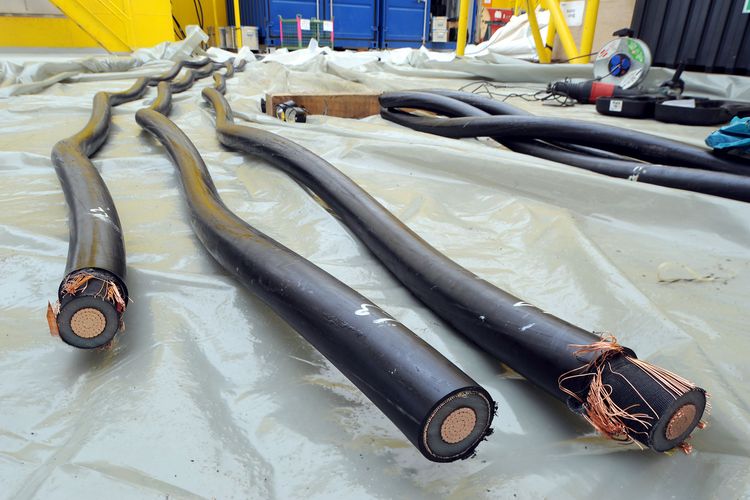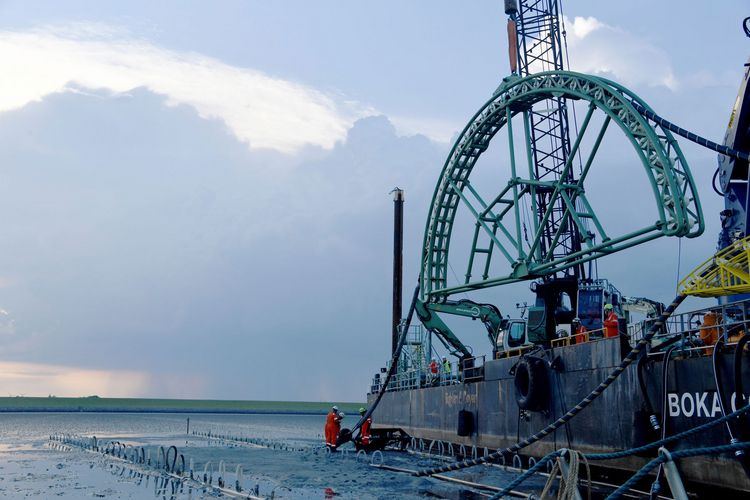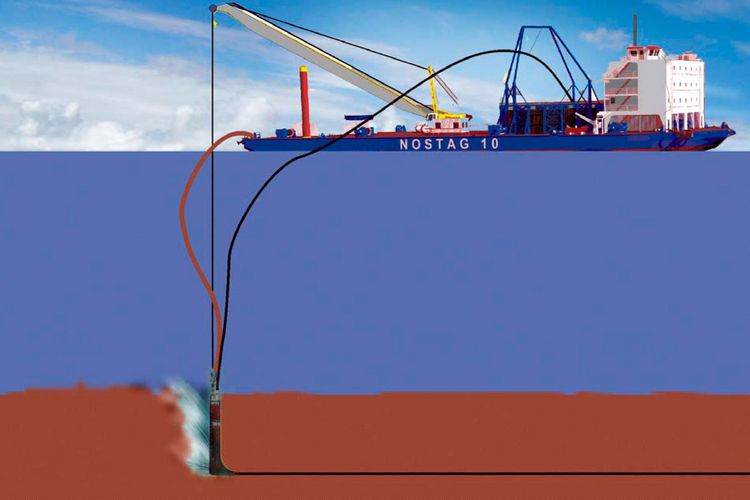17 September 2020
Companies such as SpaceX, OneWeb and Blue Origin are seeking to use swarms of satellites to send fast internet signals from space to Earth. At the moment, however, most of our internet comes from the oceans. And tech giants such as Google and Facebook are planning additional large-scale sea-cable connections.
The submarine cable which Facebook is planning in collaboration with international telecommunications providers is expected to measure some 37,000 kilometres in length. This would be almost enough cable to girdle the Earth around the equator. Indeed, the “2Africa” project aims to connect 23 countries in Africa, the Middle East and Europe. The cable is to be laid on the seabed around the entire African continent. Once it is completed as planned in 2024, it will deliver three times the capacity of all the current sea cables in Africa.
At 37,000 kilometres, “2Africa” will be just 2,000 kilometres shorter than the longest sea cable laid anywhere in the world to date: the “SEA-ME-WE 3” has connected Australia with Asia and Europe for the last 20 years. While this cable has a capacity of 20 gigabits per second, “2Africa” is expected to deliver up to 180 terabits per second – 9,000 times as much. This will be possible, among other things, because the sea cable supports the use of up to 16 fibre-optic cable pairs instead of eight. According to the calculations of the Bloomberg news agency, the installation is expected to cost up to one billion euros. Even for a sea cable, this is an enormous investment, which should, however, pay off from the point of view of the companies involved. After all, the need for fast and stable internet is growing – not only among the young population of the African continent.
Neural pathways of the internet age
Today, whenever we open a website or use the cloud services of one of the tech giants involved, the data packets usually reach us through the sea in fractions of a second. At the beginning of 2020, some 406 sea cables with a total length of 1.2 million kilometres were in operation worldwide. According to Google's estimates, around 98 percent of international internet traffic is currently handled by these submarine cables. And this is for good reasons: sea cables allow data communication to take place over enormous distances and can transport much larger amounts of data in a significantly shorter time than the most powerful communications satellites in orbit – all thanks to fibre optic technology.
© picture allianceThinner than expected: undersea glass fibre cables.
With this technology, optical signals are transmitted using light pulses. So it is photons that fly through the fibres, each of which is no thicker than a human hair, rather than electrons making their comparatively stately progress along a copper cable. And while the signal strength of copper cables decreases after only a few kilometres, the speed of the data packets in fibre optic cables remains almost constant even over great distances. Provided, of course, that the cables don’t sustain damage in the marine environment. Because then the affected areas have to be repaired at great expense (see box). During the repair work, which can take weeks, the data are redirected to another cable, which can result in slow or interrupted connections.
Getting the internet seaworthy
Companies invest a colossal amount of money and energy in keeping these precious data arteries as healthy as possible. Before laying a new sea cable, a research team first examines the seabed between the landing points. Based on their findings, experts then determine a cable route that is accurate down to the very last metre. When routing, they take into account the locations of nature reserves and geological features and the course of shipping lanes. The idea is to avoid earthquake zones, active volcanoes and coral reefs in particular as far as possible. The course and nature of the cable route determine the extent to which the cable is armoured and the technology used to lay it.
© picture allianceThe cables are laid by special ships
The glass fibres themselves are encased in copper, through which electricity is fed to operate the cable. This is followed by a layer of silicone gel, several layers of extra-strong steel fibres and, finally, an outer skin of tarred nylon to arm the cable against the harsh conditions in the sea – against rock falls, strong currents and, of course, the chronically corrosive effect of salt water.
Broadband from a garden hose
If, when you think of submarine cables, you have in your mind a picture of cable looms the thickness of lampposts, you’re quite wide of the mark, at least when it comes to greater distances. In the open sea and at a depth of up to 8,000 metres, the diameter of the cable is no greater than that of a thick garden hose. Here in the depths of the ocean, the cable only rests on the seabed. In shallower regions, the data line has more armour and is buried in the seabed to boot, especially in areas near the coast. In the case of harder ground, a sea milling machine is used; with softer, sandy soils, the cable is ploughed in or spooled in with compressed air. The “2Africa2” sea cable is to be sunk up to three metres into the seabed – about one metre deeper than previous cables, according to Facebook. The intention here is to offer the precious neural pathways of the internet even greater protection from the damage caused by trawl nets and ship’s anchors.
After all, the greatest danger to sea cables doesn’t come from nature, but from man. Fishing and shipping companies are provided with maps showing the cables. Nevertheless, according to figures from US company TeleGeography, fishing nets cause 38 percent of all damage, whereas ship anchors are responsible for one in four incidences of damage to cables. A further 11 percent of all incidences are caused by other kinds of human activity.
Natural events such as earthquakes and natural wear and tear below sea level, on the other hand, account for just over one-eighth of the damage. And even though a video doing the rounds online caused quite a stir a few years ago, showing as it did a shark taking a big bite into a submarine cable, these and other denizens of the depths have nothing to do with breaking the internet. According to data from the International Submarine Cable Protection Committee (ICPC), fish bites were responsible for exactly zero point zero percent of damage to deep-sea cables between 2007 and 2014.
Cable-laying ships at crawl speed
The cables are laid by special ships. But before these can set off on their months-long voyages, the cable must first be carefully stowed away in a long-drawn-out process. Depending on the length of the cable, it can take two to four weeks for the thousands of tons of sea cables to be safely stowed on board. And even when the vessel sets out to sea, the work is very slow. A cable layer will travel across the ocean at just under ten kilometres per hour – the cruising speed of ocean-going vessels is usually between 27 and 37 kilometres per hour. The reason for this stately pace is to avoid damage to the cable: the speed of the cable layer must be precisely matched to the composition and consistency of the seabed below.
© picture allianceIn areas near the coast, the data line is buried in the seabed to boot.
Heavy seas are an unavoidable fact of life during long journeys across the ocean. If things get really turbulent, the crew is sometimes forced to cut the cable to enable the ship to seek refuge in calmer waters. Once the storm subsides, the loose end, which is floating on a buoy, will then be reconnected to the rest of the cable on board the vessel.
Internet giants below sea level
Whereas in the past it was mainly the telecommunications companies that laid submarine cables and then rented them out, today it is the digital companies themselves that are increasingly moving into this market. Microsoft, Google and Facebook already control or rent more than half of the world's bandwidth. And they are increasingly laying internet arteries in the oceans themselves. Facebook and Microsoft combined to install the 6,600-kilometre “Marea” cable in the Atlantic Ocean between Virginia Beach in the US and Bilbao in Spain. Together with Google and other companies, Facebook is also involved in the Pacific Light Cable Network between Los Angeles and Hong Kong, which is over 12,000 kilometres long. Google is already operating or building three submarine cable connections of its own: “Curie” between the US and Chile, “Dunant” between the US and France, and “Equiano”, which connects Portugal with Nigeria and South Africa.
With their own sea cables, the tech giants are looking to increase their independence, eliminate the rental costs for the use of the cables and reliably supply their customers overseas with large and stable bandwidth. Google announced its next project in July. The “Grace Hopper” submarine cable is to connect the US with Great Britain and Spain as of 2022. This will increase capacity and offer better support for Google services such as Meet, Gmail and Google Cloud.
According to the company, the cable, named after a US computer pioneer, will use a novel fibre switching architecture that can redirect traffic more effectively in the event of an break. Moreover, the search engine giant also wants to use “Grace Hopper” to set new standards in terms of transmission speed: The sixteen fibre-optic pairs should be able to shoot 340 to 350 terabits of data per second through the Atlantic. According to Google, this would be enough to allow 17.5 million people to stream videos in 4K resolution at the same time.
The times surely have changed, as have the technologies. It was back in 1858 that the first transatlantic submarine cable between Great Britain and North America was completed. For its inauguration, Queen Victoria sent a message to US President James Buchanan, which reached its recipient after 16 hours.
Diving robots and deep-sea fishing: How submarine cables are repaired
If a cable fault is detected, a repair team must set off within 24 hours, a deadline provided for in the current contracts. For this reason, repair ships are kept on standby all over the world. Once they reach the target area, the experts on board use electronic aids to search for the damaged area. A diving robot then examines the situation directly, and the defective cable is fetched up from the seabed with special anchors and capped at the damaged site. The intact end is then attached to a buoy and parked on the surface. On board, meanwhile, the affected section is replaced by a piece of equal length. The cable ends are then joined up again, and, after extensive functional tests, the cable is returned to the depths. It can take several weeks for the repair to be completed and for data to be able to pass through the submarine cable once more.





